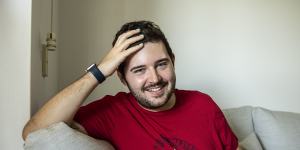Lone-person households have also become more common in Sydney,climbing by nearly 81,000 to 424,713 during the past decade as the effects of an ageing population reshape the city.

Herald analysis of ahead of Valentine’s Day shows that in the Sydney South-Haymarket area,half of those aged 15 and over did not have a live-in partner in 2021,up from 45 per cent a decade earlier. The next highest was Chippendale (49 per cent),Strathfield-East (48 per cent),Burwood (47 per cent) and Surry Hills (45 per cent).
Sydney-based social researcher Mark McCrindle said one reason for this pattern is that young people,who are less likely to have a live-in partner,tend to cluster near inner-city job hubs and universities. High-density housing in inner-city suburbs is also more suited to young singles without dependents.
“Those inner-city suburbs are close to where young people are studying and close to where they are working,but either way they are there for vocational reasons,not family reasons,” McCrindle said.
Parts of western Sydney have also seen a big increase in adults who don’t live with a partner. In Cabramatta-Lansvale,near Liverpool,the share of people in that category jumped 6 percentage points during the past decade to 44 per cent. The area is home to 10,600 singles,the largest number in any Sydney neighbourhood.
Sydney’s most partnered-up areas – those with a high share of couples married or living together – were West Pennant Hills in the city’s north (54 per cent) along with Woronora Heights (53 per cent) and Illawong-Alfords Point (53 per cent) in the south.
Single residents were relatively scarce in new suburban growth areas to the city’s north-west,which have a high share of detached homes attractive to couples with children.
In Marsden Park-Shanes Park near Windsor,only 17 per cent of people aged 15 and over did not live with their partner,while in nearby Box Hill-Nelson the share was 18 per cent. The Gledswood Hills-Gregory Hills area near Campbelltown was another suburban pocket where the rate of adults not living with a partner was low (20 per cent).
The,conducted by the Bureau of Statistics in August 2021,identified married couples and de facto couples along with those “not married”,which included people who live alone,with other family members,and in shared accommodation.
Sydney the lowest city in solo household rankings
The share of lone-person households in Sydney rose from 22.6 per cent to 23.2 per cent during the decade to 2021. That trend is consistent with an ageing population because a significant proportion of lone-person households are occupied by elderly people.

However,the share of lone households in Sydney is well below the national rate and lower than in every other capital city. Lone households were most prevalent in Hobart and Adelaide – 27.7 per cent in both.
One reason lone-person households are less prevalent in Sydney is the,especially housing costs,which makes it more difficult for people to live alone compared with most other parts of the country.
Macquarie University demographer Professor Nick Parr said another contributor to the lower rate of people living alone is the high number of relatively young new migrants who settle in Sydney.
“Compared to the national pattern,Sydney has a lower proportion in those older age groups,” he said.
The national share of single-person households rose above one in four for the first time in the 2021 census (25.6),up from 24.3 per cent a decade earlier.
Inner-city living mixed with suburbia drawing singles to Strathfield
Living in Strathfield,26-year-old Oliver Rich moved from his family home to a house in the inner-west suburb,becoming part of the growing number of singles in the area.
As part of an analysis by theHerald,the number of adults who don’t live with a partner has been on the rise,as 48 per cent of people aged 15 and over in the Strathfield (East) statistical area were taking up single living.

Oliver Rich is part of Strathfield’s growing single population.Steven Siewert
After deciding to move from the family home in the north shore 10 months ago,Rich said Strathfield appealed to him as it had an equal distance between the city and his relatives.
The suburb was typically an area for families,however singles like Rich are becoming increasingly common due to the convenience and lifestyle of the area.
“It’s super convenient. It’s only 15 minutes away from the city and there’s quite a lot of train stations,and they’re just about to build a metro,and it’s gentrifying quite a bit now,” he said.
“A lot more places are coming up,like restaurants and cafes are popping up,which is good,so it’s a good spot.”
Rich said the balance between singles and couples in Strathfield was a positive but could also make his dating life difficult.
“Where I live is like a combo of both,there’s young people but there’s also suburbia in the sense that there’s young families and kids,so it’s not like the dating pool is huge,” he said.
“Also I’m gay so that takes out like 90 per cent of potential people,so it’s a small pool to begin with.”
As a young professional in the social media industry,Rich said online dating apps had become the preferred method of choice for most people his age,making it challenging to find a partner.
“I think that the majority of people are online,so much of our life is online now[and] dating has also moved to that. It’s a totally valid way to meet people through a dating app or something,” he said.
“No one goes up to a bar and chats someone up anymore. That’s freaky.”
While the modernisation of dating has its benefits,Rich said a big reason he and others in his area are likely still single is due to the issues of the digital era.
“You can always swipe,there’s always another person coming up so you’ll be more hesitant to stop and chat to the one person you potentially might like,” he said.
The Morning Edition newsletter is our guide to the day’s most important and interesting stories,analysis and insights..